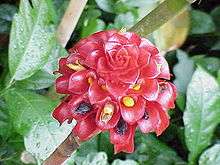Costaceae
Costaceae, or the Costus family, is a family of pantropical monocots. It belongs to the order Zingiberales, which contains horticulturally and economically important plants such as the banana (Musaceae), bird-of-paradise (Strelitziaceae), and edible ginger (Zingiberaceae). The seven genera in Costaceae together contain about 143 known species[2] (1 in Monocostus, 2 in Dimerocostus, 16 in Tapeinochilos, 2 in Paracostus, c. 8 in Chamaecostus, c. 5 in Hellenia, and c. 80 in Costus).[3] They are native to tropical climates of Asia, Africa, Central America, and South America. Several species are frequently found in cultivation.
| Costaceae | |
|---|---|
 | |
| Tapeinochilos ananassae of the family Costaceae | |
| Scientific classification | |
| Kingdom: | Plantae |
| Clade: | Tracheophytes |
| Clade: | Angiosperms |
| Clade: | Monocots |
| Clade: | Commelinids |
| Order: | Zingiberales |
| Family: | Costaceae Nakai[1] |
| Genera | |
Description
The simple leaves are entire and spirally arranged, with those toward the base of the stem usually bladeless. Leaf bases have a closed sheath with a ligule, or projection at the top of the sheath.
Costaceae is different from the other families of Zingiberales in that its species have 5 fused staminodes, rather than 2 or 3, and the Costaceae contain no aromatic oils. The fused infertile stamens form a large petaloid labellum that often functions to attract pollinators. The flowers are solitary in Monocostus. In the other genera, the flowers are borne in a terminal spike that ranges from elongate to nearly capitate. Each flower is subtended by a large bract. The fruit is a berry or capsule. The rhizome is fleshy with tuberous roots.
Taxonomy
| Cladogram: Phylogeny of Zingiberales[4] | |||||||||||||||||||||||||||||||||||||||||||||||||||
|
Gallery
- Tapeinochilos ananassae (wax ginger)
 Cheilocostus speciosus (crêpe ginger)
Cheilocostus speciosus (crêpe ginger)_-_Bukidnon%2C_Philippines_01.jpg) Spirally arranged leaves of wild Cheilocostus speciosus
Spirally arranged leaves of wild Cheilocostus speciosus
References
- Angiosperm Phylogeny Group (2009). "An update of the Angiosperm Phylogeny Group classification for the orders and families of flowering plants: APG III". Botanical Journal of the Linnean Society. 161 (2): 105–121. doi:10.1111/j.1095-8339.2009.00996.x. Archived from the original (PDF) on 2017-05-25. Retrieved 2013-06-26.
- Christenhusz, M. J. M.; Byng, J. W. (2016). "The number of known plants species in the world and its annual increase". Phytotaxa. Magnolia Press. 261 (3): 201–217. doi:10.11646/phytotaxa.261.3.1.
- Chelsea D. Specht & Dennis Wm. Stevenson. 2006. "A new phylogeny-based generic classification of Costaceae (Zingiberales)".Taxon 55(1):153-163. (See External links below).
- Sass et al 2016.
Bibliography
- Sass, C; Iles, WJ; Barrett, CF; Smith, SY; Specht, CD (21 January 2016). "Revisiting the Zingiberales: using multiplexed exon capture to resolve ancient and recent phylogenetic splits in a charismatic plant lineage". PeerJ. 4: e1584. doi:10.7717/peerj.1584. PMC 4727956. PMID 26819846.
External links
| Wikimedia Commons has media related to Costaceae. |
| Wikispecies has information related to Costaceae |
- Classification of Costaceae
- Hellenia, the correct name for Cheilocostus At volume 151 At Online Content At Phytotaxa
- Distribution Map And Genus list At Costaceae At Zingiberales At: Trees At: APweb At: botanical databases At: About Science & Conservation At: Missouri Botanical Garden
- Family Costaceae